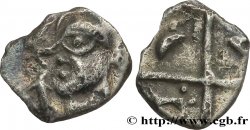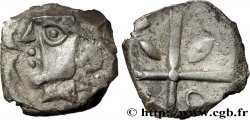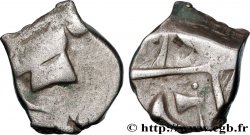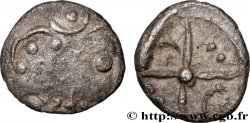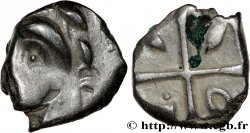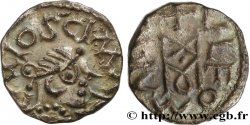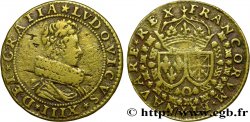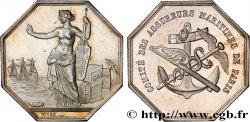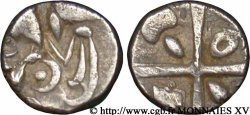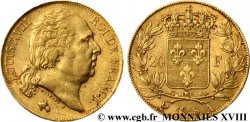v28_0535 - GALLIA - SOUTH WESTERN GAUL - VOLCÆ TECTOSAGES (Area of Toulouse) Drachme “à la tête cubiste”, lourde
MONNAIES 28 (2007)
Starting price : 250.00 €
Estimate : 400.00 €
unsold lot
Starting price : 250.00 €
Estimate : 400.00 €
unsold lot
Type : Drachme “à la tête cubiste”, lourde
Date: IIe siècle av. J.-C
Metal : silver
Diameter : 15,9 mm
Orientation dies : 4 h.
Weight : 3 g.
Rarity : R2
Coments on the condition:
Très bel exemplaire bien centré avec néanmoins une faiblesse de frappe sur le droit. Fine patine grise et homogène
Catalogue references :
Predigree :
Cet exemplaire provient de la collection de G. Savès
Obverse
Obverse legend : ANÉPIGRAPHE.
Obverse description : Tête stylisée à gauche ; calotte frontale hémisphérique proéminente se terminant à sa base par un trait figurant le nez ; joue massive formant avec la mâchoire un bloc rectangulaire dont la seule saillie est le menton ; oreille arrondie et pointée, au centre d'une chevelure abondante et ovoïde au sommet et en mèches parallèles à l'arrière ; deux dauphins opposés devant la bouche.
Reverse
Reverse legend : ANÉPIGRAPHE.
Reverse description : Croix formée de quatre cantons ornés chacun d'une lunule : balle de fronde aux 1er et 2e cantons, une hache au 3e et un pendant en ellipse au 4e canton.
Commentary
Il semble que G. Savès se soit plutôt focalisé sur la typologie, en mettant un peu de côté la métrologie pour son classement. Cet exemplaire de poids lourd, a un style particulier. Il semble raisonnable de le rattacher aux premières émissions de têtes cubistes, probablement contemporaines des monnaies dites languedociennes.
Au revers, la lunule du quatrième canton étant dédoublée, on pourrait supposer que ce motif a été obtenu sur le coin grâce à l'aide d'un poinçon ?.
It seems that G. Savès focused more on typology, putting metrology somewhat aside for his classification. This heavyweight example has a particular style. It seems reasonable to link it to the first issues of Cubist heads, probably contemporary with the so-called Languedoc coins. On the reverse, the lunula of the fourth canton being doubled, one could suppose that this motif was obtained on the die with the help of a punch?
Au revers, la lunule du quatrième canton étant dédoublée, on pourrait supposer que ce motif a été obtenu sur le coin grâce à l'aide d'un poinçon ?.
It seems that G. Savès focused more on typology, putting metrology somewhat aside for his classification. This heavyweight example has a particular style. It seems reasonable to link it to the first issues of Cubist heads, probably contemporary with the so-called Languedoc coins. On the reverse, the lunula of the fourth canton being doubled, one could suppose that this motif was obtained on the die with the help of a punch?








 Report a mistake
Report a mistake Print the page
Print the page Share my selection
Share my selection Ask a question
Ask a question Consign / sell
Consign / sell
 Full data
Full data